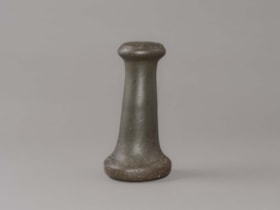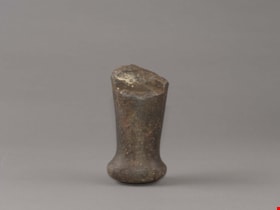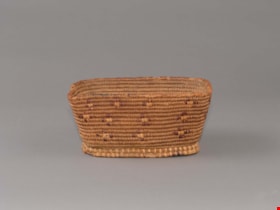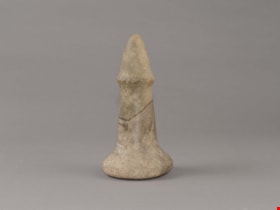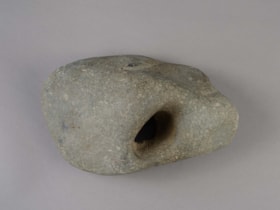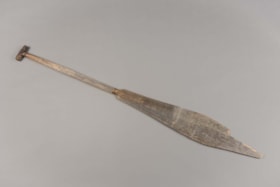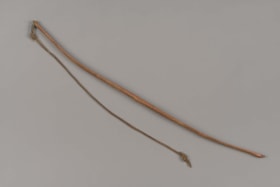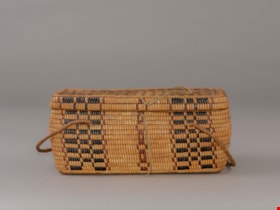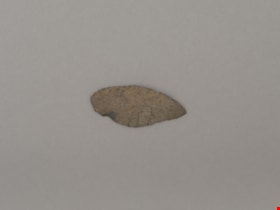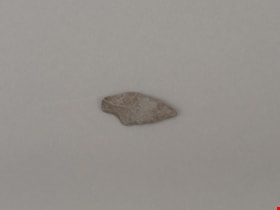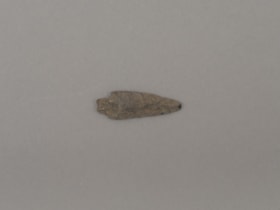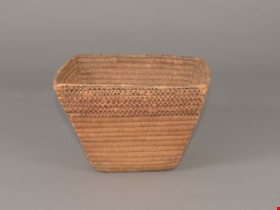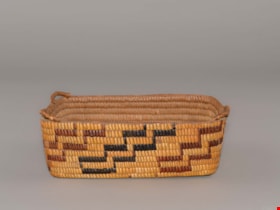Narrow Results By
Subject
- Archeological Specimen 33
- Armament 18
- Celebrations - Centennials 1
- Clothing - Footwear 1
- Clothing - Outerwear 1
- Container 13
- Container - Baskets 13
- Food Service Tools and Equipment 1
- Indigenous peoples 1
- Indigenous peoples - British Columbia
- Indigenous peoples - British Columbia - Art 2
- Indigenous peoples - British Columbia - Baskets 4
Nu-tka : the history and survival of Nootkan culture
https://search.heritageburnaby.ca/link/museumlibrary7468
- Repository
- Burnaby Village Museum
- Collection
- Reference Collection
- Material Type
- Textual Record
- Call Number
- 970 NUT v. 7, no. 2
- Contributor
- Efrat, Barbara S., 1935-2017
- Langlois, W. J., 1949-
- Place of Publication
- Victoria, British Columbia
- Publisher
- Aural History Program, Ministry of Provincial Secretary and Travel Industry, Provincial Archives of B.C.
- Publication Date
- 1978
- Series
- Sound heritage; v. 7, no. 2
- Printer
- K.M. MacDonald, Queen's Printer
- Physical Description
- 65 p. : ill. (some col.), map ; 27 cm.
- Library Subject (LOC)
- Nootka Indians--History
- Nootka Indians--Social life and customs
- Indigenous peoples--British Columbia--Vancouver Island
- British Columbia--Vancouver Island
- Indigenous peoples--British Columbia--History
- Oral history
- Oral history--British Columbia
- British Columbia--History
- Periodicals
- Notes
- "Edited by Barbara S. Efrat and W.J. Langlois." -- title page
- "This volume is the second part of a two-part series to commemorate the Captain Cook Bicentennial. It is the intent of the editors that the two volumes should form one unit. The first volume Nu-tka : Captain Cook and the Spanish Explorers on the Coast provides historical background on the contact period. W.J.L. " -- title page
Nu-tka : Captain Cook and the Spanish explorers on the coast
https://search.heritageburnaby.ca/link/museumlibrary7469
- Repository
- Burnaby Village Museum
- Collection
- Reference Collection
- Material Type
- Textual Record
- Call Number
- 970 NUT v. 7, no. 1
- Contributor
- Efrat, Barbara S., 1935-2017
- Langlois, W. J., 1949-
- Place of Publication
- Victoria, British Columbia
- Publisher
- Aural History Program, Ministry of Provincial Secretary and Travel Industry, Provincial Archives of B.C.
- Publication Date
- 1978
- Series
- Sound heritage; v. 7, no.1
- Library Subject (LOC)
- Cook, James, 1728-1779
- Nootka Indians--History
- Indigenous peoples--British Columbia--History
- Oral history
- Oral history--British Columbia
- British Columbia--History
- Botany
- Plants, Useful--British Columbia --History
- Periodicals
- Notes
- "Edited by Barbara S. Efrat and W.J. Langlois." -- title page
- "The editors of this volume have chosen to emphasize the linguistic spelling of the word Nootka. The word NU-TKA means " circling about" and is explained in detail by the excellent account of Mrs. Winifred David on page 55. " -- title page
- "This volume is the first part of a two-part series to commemorate the Captain Cook Bicentennial. It is the intent of the editors that the two volumes should form one unit. The second volume Nu-tka : the history and survival of Nootkan culture will follow in short order . W.J.L. " -- title page
- Includes bibliographical references
Lillooet stories
https://search.heritageburnaby.ca/link/museumlibrary7465
- Repository
- Burnaby Village Museum
- Collection
- Reference Collection
- Material Type
- Textual Record
- Call Number
- 398.2 LIL
- Contributor
- Bouchard, Randy
- Kennedy, Dorothy I.D.
- Place of Publication
- Victoria, British Columbia
- Publisher
- Aural History, Provincial Archives of British Columbia
- Publication Date
- 1977
- Series
- Sound heritage ; v. 6, no. 1
- Physical Description
- ii, 78 p. : ill. ; 27 cm.
- Library Subject (LOC)
- Folklore--Canada
- Legends--British Columbia
- Oral history
- Oral history--British Columbia
- British Columbia--History
- Periodicals
- Subjects
- Indigenous peoples
- Indigenous peoples - British Columbia
- Indigenous peoples - British Columbia - Social life and customs
- Notes
- "edited and revised by Randy Bouchard and Dorothy I.D. Kennedy." -- title page.
Sound heritage : volume 5, number 4
https://search.heritageburnaby.ca/link/museumlibrary7476
- Repository
- Burnaby Village Museum
- Collection
- Reference Collection
- Material Type
- Textual Record
- Call Number
- 971.1005 SOU v. 5, no. 4
- Place of Publication
- Victoria, BC
- Publisher
- Aural History Provincial Archives of British Columbia
- Publication Date
- 1976
- Printer
- K.M. MacDonald, Queen's Printer
- Physical Description
- vi, 80 p. : ill. ; 27 cm.
- Library Subject (LOC)
- Oral history
- Oral history--British Columbia
- British Columbia--History
- Haida Art
- Indigenous peoples--British Columbia
- Indigenous peoples--British Columbia--Languages--Study and Teaching
- Indigenous peoples--British Columbia--Social Life and Customs
- Indigenous peoples--British Columbia--Social Conditions
- Periodicals
- Notes
- "W.J. Langlois, Editor ; Janet Cauthers, Assistant Editor ; Derek Reimer, Assistant Editor." -- title page.
- "Robert Levine, Guest Editor." -- title page
- Includes bibliographical references
- Contents: Introduction: Native Lauguages and Culture The Hesquiat Project : Research in Native Indian Aural History My Own Native Land : Some Reflections On The Lives of Native People Recording In The Native Language The Suppression of B.C. Languages : Filling In The Gaps In The Documentary Record Interview With Francis Williams, Haida Artist
Sound heritage : volume 4, number 2
https://search.heritageburnaby.ca/link/museumlibrary7475
- Repository
- Burnaby Village Museum
- Collection
- Reference Collection
- Material Type
- Textual Record
- Call Number
- 971.1005 SOU v. 4, no. 2
- Place of Publication
- Victoria, BC
- Publisher
- Aural History Provincial Archives of British Columbia
- Publication Date
- 1975
- Printer
- K.M. MacDonald, Queen's Printer
- Physical Description
- viii, 54 p. : ill. ; 27 cm.
- Library Subject (LOC)
- Oral history
- Oral history--British Columbia
- British Columbia--History
- Goodwin, Ginger
- Lillooet Indians--Folklore
- Fraser, Simon, 1776-1862
- Haida Indians --Folklore
- Indigenous peoples--British Columbia
- Indigenous peoples--British Columbia--History
- Folklore--Canada
- Carr, Emily, 1871-1945
- Sound recordings--Canada
- Periodicals
- Notes
- "W.J. Langlois, Editor ; Janet Cauthers, Assistant Editor ; Derek Reimer, Assistant Editor." -- title page.
- "David Day, Guest Editor." -- title page. Contents: Foreward - Ernest Hall (Provincial Secretary) Notes on Contributors Introduction: Aural history, Regional studies and literature in British Columbia The Creation of Man: The Creation of Man: One The Creation of Man: Two How the Animals and Birds Got Their Names The Kiskatinaw Songs: Stranger Song Captive Song Inside Song Sorcerer's Song The Exploration: How Simon Fraser Saw the Lillooets How the Lillooets Saw Simon Fraser For Simon Fraser My Father Simon Fraser The Mackenzie Fraser Thompson River Plot Eustice Smith - Two Histories The Ginger Goodwin Controversy Sergeant Lees' View William Pritchard's View Cumberland Graveyard, February 1973 Ginger: A play Four Statements on Work Prarie Letter The Cowichan The Tooth Journal Entry Emily Carr: Poem from: Emily Klee Wyck: An Interview A Short Trip With Young Emily The Spoils of War : Three Veterans/Three Poems Canada at War At Bay With Big Dutch Remembering Esquimalt Skookum Country D.N.A. Stereo Tape Magazine
Sound heritage : volume 3, number 1
https://search.heritageburnaby.ca/link/museumlibrary7471
- Repository
- Burnaby Village Museum
- Collection
- Reference Collection
- Material Type
- Textual Record
- Call Number
- 971.1005 SOU v. 3, no. 1
- Place of Publication
- Victoria, British Columbia
- Publisher
- Aural History Institute of British Columbia
- Publication Date
- 1974
- Physical Description
- ii, 42 p. : ill ; 28 cm.
- Library Subject (LOC)
- Oral history
- Oral history--British Columbia
- British Columbia--History
- Indigenous peoples--British Columbia--History
- Indigenous peoples--British Columbia
- Sound--Recording and Reproducing--History
- Periodicals
- Notes
- Contents: Comments on the issue Guest Commentary Aural History Institute of British Columbia Aural History Convention - 1973 British Columbia Indian Language Project Report of the Oral History Committee of the Canadian Historical Association's Archives Section A View from McGill University Tape recordings in Radio Documentaries
hand maul
https://search.heritageburnaby.ca/link/museumartifact3392
- Repository
- Burnaby Village Museum
- Accession Code
- BV988.6.1
- Description
- Flat topped stone maul.
- Subjects
- Persons
- Indigenous peoples - British Columbia
- Woodworking Tools and Equipment
- Woodworking Tools and Equipment - Maul
Images
Documents
hand maul
https://search.heritageburnaby.ca/link/museumartifact3393
- Repository
- Burnaby Village Museum
- Accession Code
- BV988.6.2
- Description
- Flat topped stone maul, broken
- Subjects
- Persons
- Indigenous peoples - British Columbia
- Woodworking Tools and Equipment
- Woodworking Tools and Equipment - Maul
Images
Documents
storage basket
https://search.heritageburnaby.ca/link/museumartifact12639
- Repository
- Burnaby Village Museum
- Accession Code
- BV985.4184.1
- Description
- Tub shaped coiled cedar root basket with cedar root foundation and overcast rim. Walls of basket flare slightly towards rim. Imbricated with designs in red cherry bark and grass. Design is known as cluster of flies. The foot on the bottom of the basket, made from two extra rows of coiling, is a feature that protects the base of the basket from wear and tear. White beading on the foot. Interior Salish: Nlaka’pamux: Spuzzum possibly
- Object History
- White beading on the foot of the basket is said to be a feature typical of Spuzzum. This was reported by basket makers from that community during collections research conducted at MOA to Sharon Fortney and Bill Mclennan.
- Country Made
- Canada
- Province Made
- British Columbia
- Culture
- Nlaka'pamux
Images
Documents
hand maul
https://search.heritageburnaby.ca/link/museumartifact15555
- Repository
- Burnaby Village Museum
- Accession Code
- HV983.32.13
- Description
- Nipple topped stone maul. Nipple topped stone maul. It has a crack through the entire shaft and the two halves look of different colour and stone type. There is a large chip missing along the crack.
- Object History
- The donor was of European decent and was given this maul by an unidentified person. In general, hand mauls are used in woodworking todrive antler wedges or spreading sticks into logs and split planks. They were also used in combination with chisels for detail work. Their presence at an archeological site is viewed as evidence of long term habitations. They are associated with house building, canoe building, housepost and welcome figure carving. Nipple top hand mauls are identified as Marpole Culture (400 BC - 400 AD).
- Country Made
- Canada
- Province Made
- British Columbia
- Culture
- First Nations
- Subjects
- Persons
- Indigenous peoples - British Columbia
- Woodworking Tools and Equipment
- Woodworking Tools and Equipment - Maul
Images
Documents
stone anchor
https://search.heritageburnaby.ca/link/museumartifact15961
- Repository
- Burnaby Village Museum
- Accession Code
- HV983.60.1
- Description
- Smooth gray stone with a irregularly shaped hole on the narrower end of the stone.
- Object History
- Anchor used to secure a house post, or post supporting a wall. Large stone with hole through center,
Images
Documents
paddle
https://search.heritageburnaby.ca/link/museumartifact16839
- Repository
- Burnaby Village Museum
- Accession Code
- HV980.2.131
- Description
- Men’s paddle carved from cedar wood. The shaft is flattened with a "T" style grip mortised at top The blade is flat with one side of the tip missing. There are other cracks in the blade.
- Object History
- Style of blade indicates it is a man’s paddle, for everyday use (see Barnett 1955:116). Anthropologist Homer Barnett notes: “Paddles were made of yellow cedar, yew, and maple. Those of maple and cedar were painted, the man’s being black and the woman’s red. A smoky pitch fire and oil gave an impenetrable black (116). Men’s paddles had a crutch or crosspiece handle – either one piece or doweled on. There were different shapes of paddles for women, steering, sealing and night hunting.
- Marks/Labels
- "Yale" written on tag.
- Country Made
- Canada
- Province Made
- British Columbia
- Site/City Made
- Yale
- School/Style
- Coast Salish
Images
Documents
hunting bow
https://search.heritageburnaby.ca/link/museumartifact16840
- Repository
- Burnaby Village Museum
- Accession Code
- HV980.2.132
- Description
- Small maple hunting bow. A leather thong is tied to one end of the bow. It is loose at the other end, although, there is a knot that could slip over the bow. There are traces of green paint on the wood. Interior Salish: Nlaka’pamux: Spuzzum First Nation
- Object History
- Homer Barnett writes about Coast Salish bows: “the main hunting bow did not differ from the one used in fighting. It was made of yellow cedar root when this wood could be obtained from the mountains. The trunk wood was also used. An alternative was yew. Inferior bows for ducks and other birds were made from hardhack. Bows were about three or four feet long/ The were rather flat and were about the breadth of three fingers at the widest parts on either side of the grip, which was constricted and slightly thicker. They tapered from the centre towards both ends. The ends were curved away from the holder for a better string purchase (1955:100)
- Plant fibres were seldom made into bow strings. More common were two-ply cords of sinew or gut. Atypically, a skin thong was used (1955:101).
- Marks/Labels
- There is writing inscribed on the inside of the bow, which reads: “1925" "Made for me by Spuzzum chief.”
- Country Made
- Canada
- Province Made
- British Columbia
- Site/City Made
- Spuzzum
- School/Style
- Coast Salish
- Culture
- Nlaka'pamux
Images
Documents
storage basket
https://search.heritageburnaby.ca/link/museumartifact17680
- Repository
- Burnaby Village Museum
- Accession Code
- HV978.2.12
- Description
- Rectangular coiled cedar root basket with cedar slat foundation. Parallel slat construction for lid, which is covered in beaded designs. Overcast handles attach to the front and back of basket at both ends. Conoid lid fits overtop of the basket, rather than lying flat. Basket body is completely imbricated with canary grass, black-dyed and red cherry bark. This amount of decoration more common on older pieces and was used to protect the surface of the basket. Leather hinges attach lid to body of basket and there are leather ties at front on lid and body of basket. Possible ladder design. Interior Salish: Nlaka’pamux
- Country Made
- Canada
- Province Made
- British Columbia
- Culture
- Nlaka'pamux
Images
Documents
basket
https://search.heritageburnaby.ca/link/museumartifact17681
- Repository
- Burnaby Village Museum
- Accession Code
- HV978.2.13
- Description
- Nut-shaped, coiled cedar root basket with cedar root foundation and watch-spring base and lid construction. Hinged lid is attached with leather ties. Covered in beading, where in the decorative elements are laid flat on surface, rather than folded into cedar root stitches as is done with imbrication. Designs are in red and black dyed cherry bark. Interior Salish: Nlaka’pamux
- Object History
- Nut-shaped baskets are identified as one of the oldest types by Haeberlin and Teit (1928: 202-3). They were used for storing berries and were also common work baskets for women, used to hold small tools – awls, thread, shells, trinkets and other odds and ends (202).
- Country Made
- Canada
- Province Made
- British Columbia
- Culture
- Nlaka'pamux
Images
Documents
projectile point
https://search.heritageburnaby.ca/link/museumartifact19193
- Repository
- Burnaby Village Museum
- Accession Code
- BV002.57.6
- Description
- Projectile point, stone; rounded end. Bifacially flaked – stone removed on both sides of the point; basalt and lead shaped
- Object History
- The donor inherited this artifact from his mother, Katherine Maude (Kitty) Peers, who inherited them from her father, Louis Claude Hill. The artifacts were found on his farm, Brookfield Farm, at Douglas Road and Sperling Avenue (now site of Burnaby Village Museum).
- Culture Phase: Possibly Locarno Beach phase (3520 -2200 Before Present)
- Historic Neighbourhood
- Burnaby Lake (Historic Neighbourhood)
Images
Documents
projectile point
https://search.heritageburnaby.ca/link/museumartifact19194
- Repository
- Burnaby Village Museum
- Accession Code
- BV002.57.7
- Description
- Projectile point, stone; indented on one side. Triangular stemmed projectile point
- Object History
- The donor inherited this artifact from his mother, Katherine Maude (Kitty) Peers, who inherited them from her father, Louis Claude Hill. The artifacts were found on his farm, Brookfield Farm, at Douglas Road and Sperling Avenue (now site of Burnaby Village Museum).
- Culture Phase: Possibly Locarno Beach phase (3520 -2200 Before Present)
- Geographic Access
- Deer Lake Avenue
- Historic Neighbourhood
- Burnaby Lake (Historic Neighbourhood)
- Planning Study Area
- Burnaby Lake Area
Images
Documents
projectile point
https://search.heritageburnaby.ca/link/museumartifact19195
- Repository
- Burnaby Village Museum
- Accession Code
- BV002.57.8
- Description
- Projectile point, stone. Lancelot, parallel stemmed – stem has straight sides (squared off appearance).
- Object History
- The donor inherited this artifact from his mother, Katherine Maude (Kitty) Peers, who inherited them from her father, Louis Claude Hill. The artifacts were found on his farm, Brookfield Farm, at Douglas Road and Sperling Avenue (now site of Burnaby Village Museum).
- Longer points like this were used on spears; sometimes in combination with a tool called an atl atl (spear thrower).
- Culture Phase: Possibly Locarno Beach phase (3520 -2200 Before Present)
- Historic Neighbourhood
- Burnaby Lake (Historic Neighbourhood)
Images
Documents
berry basket
https://search.heritageburnaby.ca/link/museumartifact27527
- Repository
- Burnaby Village Museum
- Accession Code
- HV974.119.1
- Description
- Trapezoidal shaped, coiled cedar root basket with cedar slat foundation. Finished with an overcast rim with root foundation. Design elements missing from one side of the basket, which is uncommon but has been seen on cradles from the Mount Currie area (Interior Salish: Lil'wat). It was perhaps the side that rests on the wearer's back. Steeply angled sides.
- Coast Salish: Sḵwx̱wú7mesh? Interior Salish: Stl’atl’imx: Lil’wat?
- Object History
- The donor reported that the baskets were traded in the early 1920s for clothes by the donor's mother, who lived in North Vancouver. Her mother told her the "Capilano Indians" used to go door to door with their baskets in North Vancouver.
- Design elements missing from one side of the basket – possibly the side that would have rested against the owner’s back.
- Steeply angled sides keep berries from crushing those at bottom of basket. Work baskets have sides that are more rounded.
- Baskets like these were used with a woven tumpline (wool strap) that was worn against the forehead, while basket was carried on back.
- Country Made
- Canada
- Province Made
- British Columbia
- Culture
- Stl’atl’imx
Images
Documents
work basket
https://search.heritageburnaby.ca/link/museumartifact27528
- Repository
- Burnaby Village Museum
- Accession Code
- HV974.119.2
- Description
- Rectangular coiled cedar root basket with cedar slat foundation and remnants of a loopwork rim. The shiny appearance of this grass suggests it is canary grass. Black dyed and red cherry bark are used for the zigzag designs. Coast Salish: Sḵwx̱wú7mesh?
- Object History
- The donor reported that the baskets were traded in the early 1920s for clothes by the donor's mother, who lived in North Vancouver. Her mother told her the "Capilano Indians" used to go door to door with their baskets in North Vancouver.
- Zig zags are sometimes referred to as lightening or snake tracks.
- Country Made
- Canada
- Province Made
- British Columbia
- Culture
- Sḵwx̱wú7mesh
